#i saw it the first and only time when the international tour came to finland....
Explore tagged Tumblr posts
Text
need to see cats live again so bad actually
#:V#i saw it the first and only time when the international tour came to finland....#its been too long since then..#i dont suppose there are any replica productions in europe at the moment#WISH the vienna revival was still going on i could actually go there#cats needs to do a stex and settle in some random ass german town for years so i can actually go see it
0 notes
Text
Sharon of Within Temptation opens up about her darkest day
Since Within Temptation breakthrough, Sharon den Adel life was one big pink day. Until that one message.
DARKEST DAY
Leather jacket, glasses on top of her head, fresh and cheerful. This is how Sharon enters the grand café. Sunlight falls through the windows on the wooden floor and shines on the earring in her right ear, a dragonfly. Outside the trees rustle. She lives in Soest, but this cafe in Baarn is close by. And it does not matter: it is equally beautiful everywhere. An oasis of peace and green, something for a singer of a world famous metal band. No loud guitars, no busy tour schedule.
No, the band life is not always easy. Sharon really experienced that on her darkest day. It is the year 2015. She had just flown back to the Netherlands after having been on holiday with her family. Her family stayed for a while, but for Sharon and Within Temptation a few European shows were booked. She had one day in the Netherlands.
When she came home that day, she was told that someone in her immediate family was seriously and probably incurably ill. “Now it turns out that medical science is very far with new means and treatments, but for him it was unfortunately too late. He was still there, but his life was hanging on a silken thread.” Her family did not want to tell her when she was on vacation. And now, after this news, after the ground had been swept away under her feet, she had to go straight to the tour bus. Canceling was not an option: Within Temptation has become a company, with many employees, still apart from the concert halls and fans who expected her. "It was unreal. I did not want to leave, even though my family told me that I should go. I told everyone directly in the bus. On the way I was reading about the disease and what to do about it. I could not accept it."
On stage, during the shows after the news, the atmosphere was different than usual. “Music is a catalyst for me, so the emotion was interwoven with everything I sang. I missed my husband and children. I wanted to go back to my family, drink wine with my parents, talk about life."
The disadvantages of international fame. If something happens, chances are that you are abroad. The show must go on. “Sometimes that goes wrong, and that is what happened to me. When we were back in the Netherlands, I no longer had any inspiration for new music, at least not for Within Temptation. We make bombastic, tough music. There is victory in it, and I did not need that, I did not have that emotion, I was locked up.”
There was a road out of the impasse, but that road was outside the belt. "Of course the members were shocked, they were looking forward to making a new record." The songs Sharon wrote felt good, but did not fit into the standard genre. They were smaller, more sensitive. “The producer with whom I wrote them also immediately noticed. With these songs we had to do something else." This was her solo project: My Indigo. She made a record that made her blood and creativity flow again, even in such a way that she could write for Within Temptation again.
PINK DAY
She drinks her fresh mint tea, eats the biscuit and stares out of the window. The dragonfly sparkles and distracts from her frown. “A beautiful day, a beautiful day ...” When she hears that childbirths are no longer allowed, because otherwise almost all the candidates in this category would choose, she goes for the day when Within Temptation really broke through.
"It was at Pinkpop in 2001." Laughing: "Very long ago. I was 21. We were about five years old. We were already big in the underground, and we already played in large halls, but we were still in that niche of metal and alternative. The gig at Pinkpop was overwhelming. The tent was packed and popped apart. Everyone sang along. That was the tipping point, we felt that something had changed. After that we also saw people who did not belong to the metal subculture at performances and signing sessions. People of all plumes, say."
The radio stations and music channels on TV, however, still did not have it. "Nobody wanted to play us. When we drove home after Pinkpop, we heard callers on the radio requesting us, but we were not played. I remember that we were played at Radio 3 for the first time at night. You also had The Box, a music channel on TV. We had told our fans that they could request our video clip there, but that was not possible at all. We were not in the package. We got a phone call, if we would please rectify the news to our fans, because they were called flat. But it was not to stop, a few months later you could request us and we were immediately played a lot.”
It was a shift in the landscape of pop music. You did not hear metal until Within Temptation. Then suddenly. "Besides, I was a woman. You also had little to no bands with singers in metal." In other words, they actually had no chance of success. But it had happened: Within Temptation was broken by the general music lover. “That was great, but also alienating. We have always remained faithful to our music, and to what we wanted to make. I have always believed in it. We went full. And suddenly we broke through with music that people said it was not possible. We were full." They still make the music they want to make. The success remains as great as ever. Soon they will be in the AFAS Live twice in succession, and then we are only talking about the Netherlands, because they are also popular in Germany, Finland, Russia and even the USA.
She has to go, Sharon. Soon the children will be out of school. She walks outside, where the sun shines and where the squirrels and birds know nothing about loud guitars and success.
The Netherlands got to know Sharon den Adel (43) as front woman of the metal band Within Temptation. Last year she announced her solo project: My Indigo. Her first (eponymous) album is now a fact. Sharon has a relationship with guitarist Robert Westerholt, with whom she has a daughter and two sons.
Translation by Hands of Darkness
37 notes
·
View notes
Text
July 5, 2018
Today in the town square they were celebrating medieval days. I took some videos of Estonian dancers reenacting Medieval dances. Their costumes were so authentic and the dancing appeared to be as well. Hopefully at some point I’ll figure out how to transfer them from the Kindle to this blog.
I entered the town square this morning to take a free tour of what they call “old town.” There was well over one hundred people for two guides they split the group in two and our guide was so amazing! A for-pay tour could not have been better. I hope she got more in tips than she would have gotten, if employed by someone else.
I’m going on this tour again before I leave, it was fact-filled to the point where I feel that I learned as much interesting history of Estonia in two hours, as I would ever want to know. The architecture was phenomenal. There was even a quite unexpected onion-domed Russian Orthodox church that I thought I’d have to go to St. Petersburg to see. We saw so many structures that originated in the 1200’s and learned about what buildings succumbed to bombings by Germany, invasion by Russia, lightening strikes, early conflicts between Denmark and Germany. I’m going to insert the Wikipedia entry on Tallinn in case you want to read more. She covered all of it, in a clever and entertaining way. She held my interest with every word. Part of her talk involved a pitch to incorporate in Estonia because they were trying to support e-commerce globally (and benefit from the taxes) so they make the legalities very easy to navigate (sounded a bit like Bermuda and Cayman Islands).
Wikipedia - Tallinn (/ˈtɑːlɪn/[4][5] or /ˈtælɪn/,[6] Estonian pronunciation: [ˈtɑlʲˑinˑ]; is the capital and largest city of Estonia. It is situated on the northern coast of the country, on the shore of the Gulf of Finland in Harju County. From the 13th century until 1918 (and briefly during the Nazi occupation of Estonia from 1941 to 1944), in languages other than Estonian, the city was known as Reval.[7] Tallinn occupies an area of 159.2 km2 (61.5 sq mi) and has a population of 450,305.[8]
Tallinn, first mentioned in 1219, received city rights in 1248,[9] but the earliest human settlements date back 5,000 years.[10] The initial claim over the land was laid by the Danes in 1219, after a successful raid of Lyndanisse led by Valdemar II of Denmark, followed by a period of alternating Scandinavian and German rule. Due to its strategic location, the city became a major trade hub, especially from the 14th to the 16th century, when it grew in importance as part of the Hanseatic League.
Tallinn's Old Town is one of the best preserved medieval cities in Europe and is listed as a UNESCO World Heritage Site.[11] Tallinn is the major political, financial, cultural and educational center of Estonia. Often dubbed the Silicon Valley of Europe,[12] it has the highest number of startups per person in Europe[13] and is a birthplace of many international companies, including Skype. The city is to house the headquarters of the European Union's IT agency.[14] Providing to the global cybersecurity it is the home to the NATO Cyber Defence Centre of Excellence. It is ranked as a global city and has been listed among the top 10 digital cities in the world.[15] According to the Global Financial Centres Index Tallinn is the most competitive financial hub in Northern Europe and ranks 42nd internationally. The city was a European Capital of Culture for 2011, along with Turku in Finland.
When I first got in the group for the free tour, I asked the guide a question about costs for converting dollars to Euros. She said she didn’t know, but a 19 yo girl from England spoke up with the information. Her name is Sarah and we spent the next five and a half hours together. The three and a half hours after the tour was filled with non-stop chatting. I was definitely not as well-informed and articulate as she when I was 19. We covered almost any topic you can imagine. It was a genuine mother/daughter or friend/friend rapport. Also, something I can’t imagine happening, under any circumstances in the U.S.
Complete change of topic. It’s hard not to feel like a spoiled American when I say the fridge in my kitchen only reaches some temperature in the 40’s Fahrenheit – reminds me of our Jamaica kitchen. And the Whirlpool washing machine is less than half the size of my washer. When it’s in its spin cycle the noise sounds like what Bruce and I call the Rocket Launch lift-off from Cape Canaveral 😊
Sarah and I compared notes about life in England vs the U. S. and life as a 19 yo vs 67; found out that we had an awful lot in common including the fact that we both traveled through Europe at 19 by ourselves.
Switching topics again… in order to function better I realized recently I need to pay attention and look at things more carefully. On the cruise-ship, I inadvertently wound up putting pepper on my food twice when I only wanted salt because the table had two peppers and I didn’t look at the shaker either time. Today I managed the feat of putting on a jacket upside down – truly takes more skill than the reverse. Also kept Karma in Gracie in stitches because I managed to put on a pair of shorts backwards (no way to explain myself out of that one). I am making an effort to be more methodical about where I put stuff, so I can find it again. This is especially true in an apartment that I’ve never lived in before.
Last, the paper towels that came with the apartment and the tissues I bought at the grocery store are both so rough that I can’t tell them apart when a folded piece of either is laying on the table. I’m the toughest!
1 note
·
View note
Text
a few virtual tours, a few real tours
In this strange and unusual time of lockdown for the world, one of the biggest losses to culture and society is that of galleries and museums. They are widely visited daily, across the globe, allowing generations of people to learn about and appreciate works of art and aspects of history.
Despite this, we also live in a time where people can connect very easily online. Although some people often find this tiresome or useless, instead believing people should go out and see the world for themselves, it has proved insanely useful with current events: many galleries and museums have found a new way to use this to their advantage.
Seeing as we cannot make it to our Design Connections event and talk to artists and practitioners about their current work, I thought it would be enlightening to look back on some of the works I’ve seen before that are of historical and cultural importance, and perhaps discuss why this is and how it came to be. Also, with the additional help of some of the virtual tours now on offer online, I can take a look at some works I have yet to see, and examine those too - perhaps offering insight on why I wish to visit them.
London, April 2018
One of the most well-known galleries in the world is The National Gallery, situated in London’s Trafalgar Square. It is home to many renowned artworks by lots of famous artists. I have been a few times, most recently in April 2018.
I love the National Gallery not only for the art it houses, but for the architecture. It’s one of the best places in London just to sit, maybe near your favourite painting, and watch the world go by as tourists skim past art by some of the most renowned artists in the world.
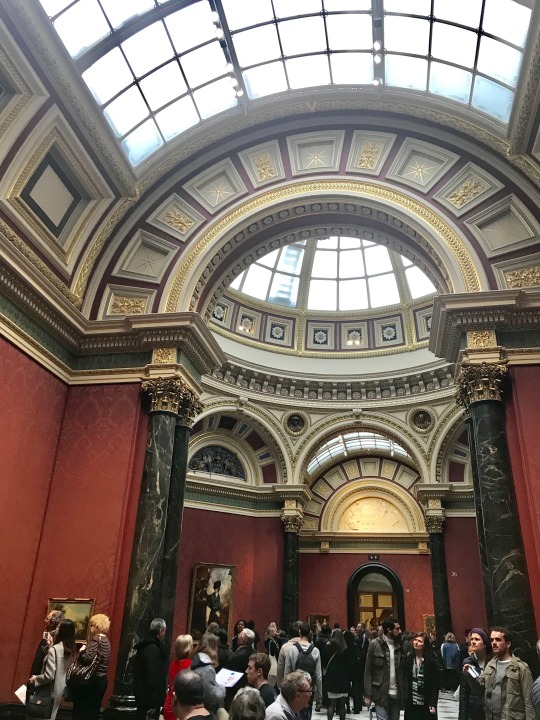
Every month the National Gallery list on their website a ‘picture of the month’, one picture from their gallery, to spotlight. April 2020′s picture of the month is one I actually took a picture of myself, in the same month two years ago. It is Akseli Gallen-Kallela’s Lake Keitele, painted in 1905 as he was recovering from malaria. Lake Keitele is in central Finland, and Gallen-Kallela, a Finnish artist, was captivated by the view. He painted it multiple times.
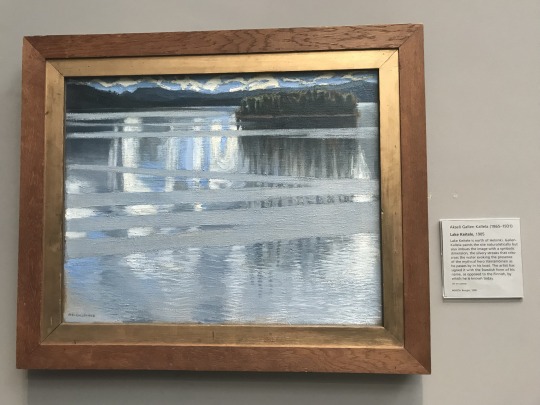
The painting is captivating, too, a mix of bright reflections and dark, sombre shadows. The National Gallery website writes that “strips of steel-grey zigzag boldly across the surface of the lake. They capture the effects of wind moving across the water and the currents beneath”. Gallen-Kallela imagined these to be down to a passing boat. The artist expressed his love of Finland through art, in a time when Finland was trying to gain independence from Russia.
Below is one of my favourite paintings of all time, displayed in the National Gallery. It was painted in 1889 by Vincent Van Gogh, one of the most famous artists of all time, and is called A Wheatfield, with Cypresses. Whilst a patient at Saint-Paul de Mausole, a psychiatric facility in the south of France, Van Gogh painted several versions of the same wheatfield. The one at the National Gallery is the final version.

Arguably, the vast majority of Van Gogh’s artworks have captured the hearts of the world, long after his death. He paints rhythmically, with swirling brush strokes that capture the movement of nature. This particular painting boasts this effect beautifully; vincentvangogh.org notes how the Cypresses stand vertical and contrast the many horizontal aspects of the work. They also note more contrasts, such as the contrast of warm colours versus cool, or sky versus land. One quote of theirs I particularly enjoyed: the work is dubbed “restless beyond measure”, which is a common feature in Van Gogh’s work. This is a perfect example.
Athens, September 2019
Athens is home to the Acropolis, and subsequently the Parthenon, which is probably the most iconic imagery associated with Ancient Greece. It has been a source of endless fascination for centuries, across the world.

Athen’s The Acropolis Museum is a much more recent museum, opened in 2009, filled to the brim with Ancient Greek artefacts excavated from the Acropolis itself. It was purpose-built to house everything found on the hill and surroundings, and there are plenty of them.
In fact, the whole of Athens seems dedicated to its history, as even the Metro stations exhibit artefacts dug up in their construction.
The Acropolis Museum is built over yet another archeological site, an ancient neighbourhood complete with a drainage system and bathhouses.

Much of the floor in the museum itself is made of glass, allowing the endless stream of visitors to view the site beneath. At the entrance to the museum there is a large drop where the remains of a bathhouse are in view. There’s also a walkway under the museum where visitors can tour the archeological site, and it is incredibly odd but also kind of touching to be immersed in ruins where people actually lived, thousands of years ago.
The Acropolis Museum, as by name, is a museum, rather than a gallery. However one area of the museum, the Archaic Acropolis Gallery, is full to the brim with sculptures and statues. Archaic refers to the period from 8th century BC until the end of the Persian Wars, or around 480 BC. This period saw immense changes in Greek language, society, art, architecture, and politics, due to the increasing population and usage of trade.
The exhibits in the Archaic Acropolis Gallery are beautifully presented on large white podiums. It is strictly no photographs, so I took none of my own (the one below is from the museum’s website). This way of exhibiting offers tourists a way of viewing the artefacts from all sides. The gallery is lit mostly using natural light through giant windows, and as the light shifts outside, the way the statues can be viewed changes too.
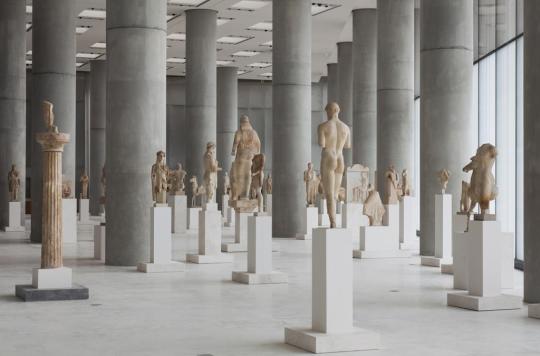
Also open is the museum’s Parthenon Gallery, seen below. It houses many of the famous Elgin Marbles, which were originally part of the Parthenon and other buildings on and surrounding the Acropolis. Most of the Marbles were removed (or stolen) by Lord Elgin who moved them to England in 1812, where they were bought by the British Museum. There has been much international pressure for them to be returned to their rightful place, especially now the Acropolis Museum houses the rest of them, but this is yet to happen. The Parthenon Gallery in Athens leaves spaces in the exhibition for the stolen pieces and displays casts of others, so it’s easily visible where the originals should be.
The sculptures once displayed on the east pediments of the Parthenon tell the tale of the birth of the goddess Athena, while those on the west depict a battle between Athena and the god Poseidon to determine who would be the patron deity of Athens (LiveScience). Although the Marbles themselves and the stories they tell are beautiful and important to Ancient Greek history, much of their coverage and popularity worldwide is down to the repatriation debate.

I adored Athens. I’ve had an interest in Ancient Greece since I was very young, and of course the capital city is the best place to visit for this purpose. It was such a joy to walk alongside the Acropolis, or to turn random corners and see a part of ancient history in the middle of the street.
Many people share this with me. For an incredibly long time Greece was the leading nation in politics, art, philosophy, society and culture, as well as the birthplace of democracy. Athens, as the country’s capital city, was an obvious epicentre. History.com write that “over the centuries, the Acropolis was many things: a home to kings, a citadel, a mythical home of the gods, a religious centre and a tourist attraction.” All this has led to a fascination among historians and tourists alike.
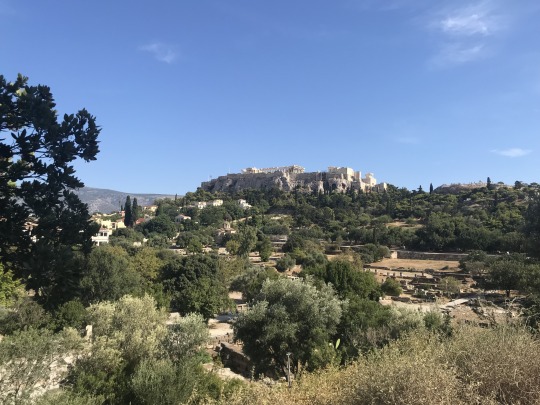
The Parthenon has been standing for over 2,000 years. It has obviously deteriorated over time, but it’s still there, and is now being renovated in a multi-million euro project. It is visible far and wide in Athens, and is an iconic symbol of not only Greek antiquity but ancient history as a whole.
It’s no wonder why the Acropolis Museum is so immensely popular. Stacked full of artefacts and pieces of history, it’s like stepping into the past.
The museum is part of Google’s Arts and Culture galleries project and therefore can be visited online, too.
Paris, January 2020
The Musée de Louvre is one of the most famous museums in the world, and for good reason. I loved wandering the halls on my trip to Paris, even when the fire alarm went off for a solid twenty minutes and not one person left in haste (truly, truly French).
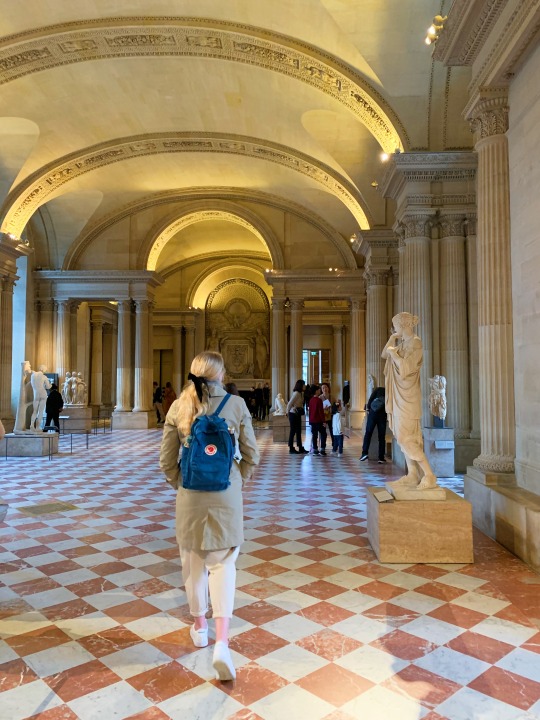
Like the Acropolis Museum, the Louvre is more of a museum than a gallery, and there are hundreds and hundreds of artefacts at the Louvre. However, one painting is the Louvre’s pride and joy. People visit the museum specifically to see Leonardo Da Vinci’s Mona Lisa, easily the most famous painting in the world. There is a carefully guarded and staffed queue system you must stand in to view the painting up close, and even then it is behind bulletproof glass (in 1956, somebody threw acid at her!).
The Mona Lisa is a perfect example of an image or painting captivating the world, and is clearly of great historical and cultural importance. Plenty of people before me, with far better knowledge and understanding, have tried to describe why exactly the Mona Lisa is so popular. Encyclopaedia Britannica’s article “Why Is the Mona Lisa So Famous?” theorises there is no single explanation, but there are plenty of reasons why the painting draws thousands of ardent admirers daily.
Clearly, the painting is very realistic and displays great technical ability. There are plenty of technically good paintings, however - in fact, the Mona Lisa is surrounded by them at the Louvre, and in the many galleries of Paris.
It could be the painting’s journey that proved it to be so popular. It became more and more well known as it travelled around France, first in the court of Frances I, King of France and part of the royal collection. In the French Revolution the collection was claimed as the property of the people, and it was only after a period in Napoleon’s bedroom that it was given to the Louvre.
The mystery of the painting’s subject has allowed the public to project an identity onto the Mona Lisa. Scholars theorise the portrait is of Lisa Gherardini, wife of the Florentine merchant Francesco del Giocondo, but there’s no proof of this as no record of a commission can be found. The speculation surrounding the painting is as much a part of culture than the painting itself.
It’s even possible that the Mona Lisa is possible because in 1911, it was stolen by Italian immigrant Vincenzo Peruggia. He was tried and imprisoned before he could sell the painting, which proved impossible due to its popularity. The ensuing media frenzy cemented the portrait into popular culture, where it has stayed for over a century.
Subsequent tours of the USA and Japan have helped it gain worldwide fame, as well as pop artists using her likeness to challenge what it means to make art and worship it. With the emergence of computers and the internet, the Mona Lisa began to be endlessly reproduced and again rose to immense popularity, to the point where I asked my sister, who has no interest in art, to name a painting - her reply was, naturally, “the Mona Lisa”.

In all honesty, the Mona Lisa is obviously part of history and I am very happy to have been able to visit her, but the Louvre is so expansive and full of interesting and beautiful things that she might even have been a little underwhelming. After all, you can't get too close, and she is behind glass. Perhaps more interesting was the painting she is facing, if only for the sheer size of it. The Wedding at Cana by Paolo Veronese (1563) depicts the biblical story of the Marriage at Cana, at which Jesus turns water into wine. It is the biggest painting at the Louvre, yet one which people often miss, what with the excitement of the painting it faces.
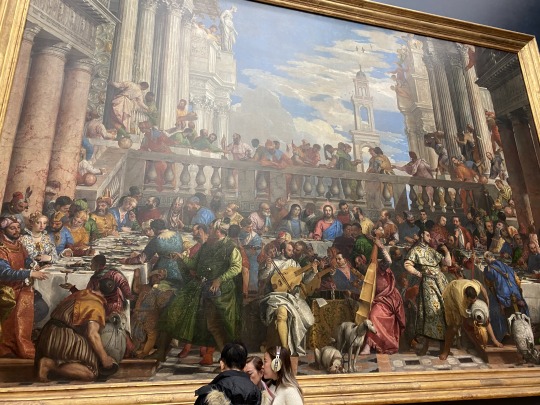
The Venus de Milo is also housed at the Louvre. It is an Ancient Greek statue thought to be the work of Alexandros of Antioch. It is believed to be a depiction of Aphrodite, but could also be of the sea goddess Amphitrite. Amphitrite was venerated on the Greek island Milos, where the statue was discovered in 1820. The statue was built from two blocks of marble and is comprised of several pieces all joined together, fixed with vertical pegs. The Louvre writes that this was common in Greek sculpture, especially in the Cyclades around 100BC, when the Venus de Milo is thought to have been sculpted. The statue is named after the Roman name for Aphrodite, ‘Venus’, and the island of Milos. Her arms were never found.
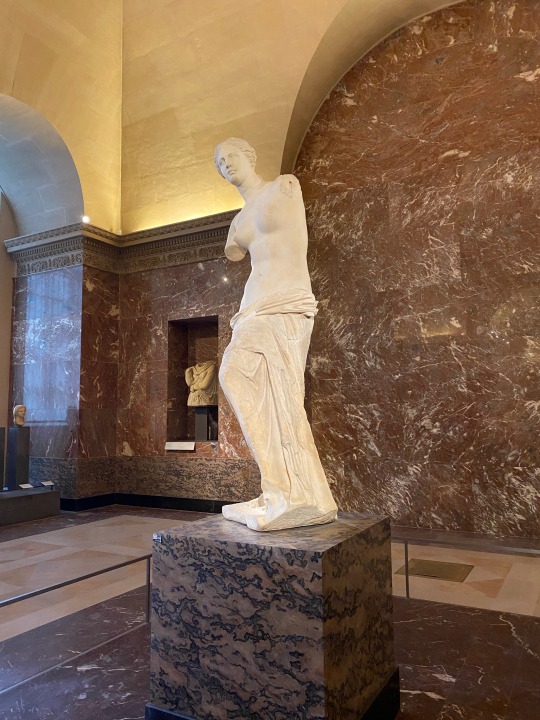
The Smithsonian note that the Venus de Milo is the most famous sculpture in the world, and “after the Mona Lisa, the most famous work of art in the world”. Despite many sculptures like it, and most sculptures from this period looking incredibly similar, she is immediately recognisable due to her missing arms. It’s probable that with her arms, the Venus de Milo would be way less popular.
She is posed in an ‘S’ curve, a feature traditional in Ancient Greek and Roman sculpture. The technique allows a more realistic distribution of weight. My Modern Met theorise she was likely “colourfully painted and adorned with jewellery, though no pigment or metal remain on the marble today”. The Louvre acknowledge that holes remain where the statue was originally adorned in metal jewellery.

Bradley Weber, Wikimedia Commons
Bob Duggan writes in his article “How the Venus de Milo Changed Female Beauty” that female nudity was not common in art and sculpture in Ancient Greece, whilst male nudity was common due to the lack of clothing in sport and competition. It wasn’t until 350 BC that Praxiteles began to sculpt the female form, and even then, the sculptures were rarely nude, instead draped in fine clothes that hinted at their outline. Venus de Milo comes way after Praxiteles, but clings onto this trend with a draped lower half.
Like the Mona Lisa, the Venus de Milo has become a staple of classical art and an iconic representation of sculpture and Greek antiquity. It can be found everywhere, including one particular episode of ‘The Simpsons’ in 1994.
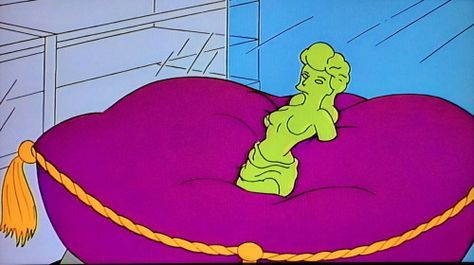
Screencap via Tumblr.
Also like the Mona Lisa, the Venus de Milo owes much of her popularity to modern art and propaganda: in fact, a specific propaganda campaign by the French in 1821, when it arrived at the Louvre. They were incredibly excited by her arrival, as the British had just bought the Elgin Marbles ripped from the Parthenon, and the Apollo Belvedere was returned to the Vatican. France were in need of an exhibit from classical Greece and, like magic, along came the Venus de Milo. However, the Venus de Milo was actually sculpted half a century after Greece’s classical age, and the Louvre's director Forbin allegedly hid her base to hide this fact.
The Art Minute write that “surely, the Venus de Milo is idealised: the features on her face are symmetrical, her breasts are small, her hips are wide, and her body is fleshy and soft”. She is the perfect example of beauty in Greece’s classical era, much changed from then to now, and offers us insight into female beauty in Ancient Greece. This was clearly their ideal if the goddess of love, beauty and sexuality was sculpted this way.
The article also says that “her twisted posture invites viewers to walk around all sides of her magnificent figure in order to see every curve and bump in her lovely form”, describing exactly what it’s like to be in her presence. Venus de Milo is 6′8″, and this affects her presence greatly also. Speaking from experience, it truly affects you to turn the corner and see her towering above you, knowing you are in the presence of part of history.
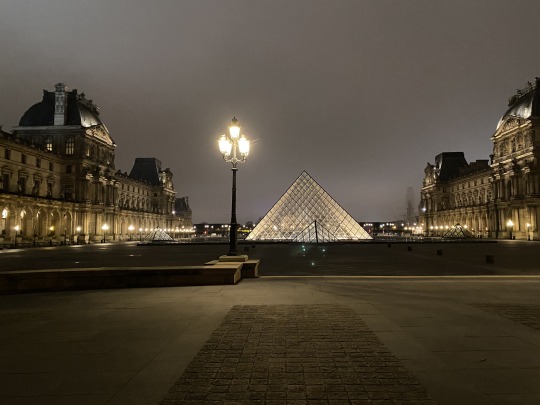
The Louvre was one of the best places I’ve ever been, and certainly one of my favourite things in Paris. It was a real bucket list moment. If you’re not lucky enough to visit the Louvre in real life, you can do it through a screen too.
Musée d’Orsay
I didn't have time to visit the Musée d’Orsay when I was in Paris, but it would be first on my list if I were to return. It houses the largest collection of impressionist and post-Impressionist masterpieces in the world, mainly French art dating from 1848 to 1914, and subsequently is home to many of my favourite artists and paintings.
Google Arts & Culture have many virtual tours available, and the Musée d’Orsay is one of them. I was delighted to find out you can essentially stand in front of some of the most famous paintings in the world, only from home, maybe in your pyjamas with a cup of tea.
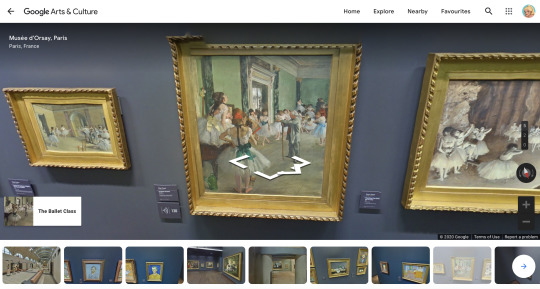
Above is The Ballet Class (or La Classe de Danse), by French artist Edgar Degas. Degas is famous for his depictions of ballerinas, as over half of his works contain dancers. The most notable of his works is the sculpture Little Dancer Aged Fourteen, the original of which is exhibited in the National Gallery of Art in NYC. Although Degas is a noted Anti-Semite and objectively cruel person, when it comes to his work I deploy a philosophy of separating the art from the artist, as I have always loved his delicate portrayals of young ballerinas in their studio.
The accompanying information given with The Ballet Class by the Musée d’Orsay reads: “more than the stage performance and the limelight, it was the training and rehearsals that interested him. Here the class is coming to an end – the pupils are exhausted, they are stretching, twisting to scratch their backs, adjusting their hair or clothes, an earring, or a ribbon, paying little heed to the inflexible teacher, a portrait of Jules Perrot, a real-life ballet master”.
This painting is captivating perhaps due to the theory of voyeurism. As the viewer, we are looking in on a scene captured from real life, without the people in it having any knowledge we are there. We have an insight into a practice most people don't see, especially people like me who cannot dance at all.
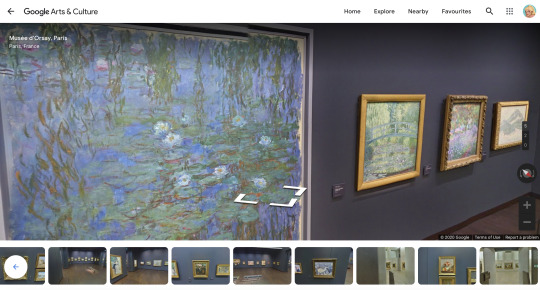
One reason why I've always wanted to visit the Musée d’Orsay is to see some of the paintings by Claude Monet. Many, many people hold Monet in high regard, listing him as one of their favourite artists, and I’m among them.
Monet bought a house in Giverny, France, in 1893. From then on, the house and its gardens became his main source of inspiration, mostly including the water lilies he planted in his water garden. Many of his paintings focus on these - the series consists of around 250 paintings - and they have become his most famous works, displayed in museums around the world.
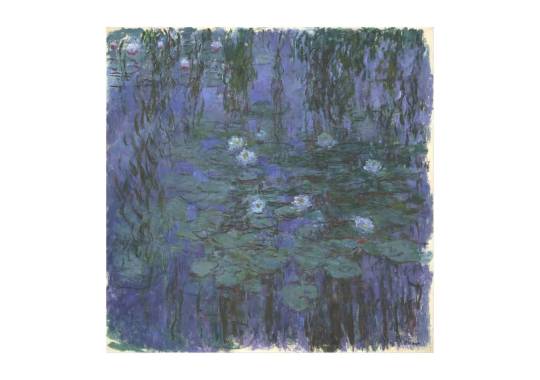
The above painting, Blue Water Lilies (or Nymphéas bleus) focuses on a very cropped, specific area of Monet’s water garden. It features few details, instead using a very abstract brush stroke and instead using colour to hint at shapes and forms. The Musée d’Orsay write: “never was the artist's brushstroke so free, so detached from the description of forms. A close-up view of the canvas gives a feeling of total abstraction, because the brushstrokes are stronger than the identification of the plants or their reflections”.
As well as this, the gallery also suggests why the painting, and those much like it, are so captivating: “the viewer has to make a constant visual and mental effort to piece together the landscape suggested in the painting”. The paintings that we really have to think about are often the ones that stick in our minds.
Although I will make it my goal to see these paintings in real life too, I found them through Google Arts & Culture’s virtual tour.
Musée de l’Orangerie
Also the home to many paintings from Monet’s Water Lilies series is the Musée de l’Orangerie. Although the museum displays works by other artists like Jean Walter and Paul Guillaume, they are most famous for their Monet collection.

As part of his Water Lilies series, Monet painted several murals. During the 1920s, two oval rooms were built at the Musée de l’Orangerie to house eight of them, and they are still there today. The above is The Water Lilies - Morning. Together, the murals show the passage of time through the day. The light shifts and changes throughout all eight, as the museum notes that “as of 1886, Monet became more interested in representing his garden according to the rythm of light variations”.
Monet’s wild popularity may be down to pure aesthetics. He painted beautiful paintings, beautiful scenes that were pleasing to the eye, using colourful palettes and free and loose brush strokes. It could be that the water lilies themselves aren't the reason why the painting are so popular. Monet ‘zoomed in’, as such, on the water itself, cropping the edges and removing the image of any horizon or skyline.

Thames and Hudson say “the works become less and less about constituent elements and orientation, and more about the energetic gestures of paintbrush and pigment... there is no frame, no single resting place for the eye, only an immersion in planes and passages of colour”.
There’s an element of freedom, and clear adoration from Monet for his surroundings, which maybe we share with him whilst viewing. The artist himself said “the water-flowers themselves are far from being the whole scene. Really, they are just the accompaniment. The essence of the motif is the mirror of water, whose appearance alters at every moment.”
I toured the Musée de l’Orangerie and the Water Lilies murals using the same method as done previously, here.
More to See
If you too are stuck indoors in 2020, or are finding this post in the future and enjoy sitting looking at paintings from the comfort of your own home, you can find lots of other virtual tours below.
The National Gallery, London, UK
National Portrait Gallery, London, UK
The British Museum, London, UK
Vatican Museums, Vatican City, Italy
The Uffizi Galleries, Florence, Italy
Picasso Museum, Barcelona, Spain
The Guggenheim, New York City, USA
The Museum of Modern Art, New York City, USA
0 notes
Text
Together We Shall Lead …. Through Friends and Fellowship with 41 Club Poland for their AGM 2017 held in Gdańsk between 16th and 18th June 2017
Dear 41 International Members,
It all started at the 41 International AGM in Sun City, South Africa, when President Karol of 41 Club Poland approached me for some minor clarification about the accounts (what else for me??). We got chatting about our days in Round Table and how it would be great to visit again. He promptly reminded me of the AGM was to be held in a few weeks time and asked him if they have international guests. He said that only a few would turn up. As 41 Club Poland is a small association, it was time to lend my support and visit. At the time I was not aware that I would have the honour to represent the Board as well.
As our 41 International President could not travel during this period in June, he asked me to stand in for him and represent 41 International at this AGM, which I gladly accepted.
This is not my first visit to Gdańsk, Poland and oh my has it changed since 2001. Many improvements have taken place and it is a great city to visit.
I arrived in Gdańsk from Malta via Amsterdam in early Friday afternoon. I was met and greeted by Lukasz Stolarczyk (IRO) and Cezary Bak (Vice President). My host for the weekend Karol Rzewuski (President) arrived soon after accompanied by my good friend Andy Waite from GB&I, who was also being hosted by Karol.
Other international guests for the AGM included Peter Good (IRO GB&I), Manfred Willms (Old Table Germany – National Secretary), Manu Eskola (Editor – Old Table Finland) and Sami Tyven (Old Table Finland OT56 Nokia), the latter two gentlemen with their respective wives.
A couple of days previous, we received a small change in the program due to the restaurant getting the date of the gala dinner wrong. SHIT (Seriously Happy International Tabling!) happens, I suppose. So, the program for Saturday and Friday evenings were interchanged with the Gala Dinner on Friday evening, as what happens in GB&I conferences.
Until the evening program we had some time to kill, so Karol suggested we go straight to Sopot where he lives and go out for a small bite to eat with his extraordinary wife Jadwiga and Andy at a small beach restaurant in Sopot, belonging to another ex-tabler from Sopot. It was a great afternoon, the sun shining, the weather beautiful and overall relatively warm. Later on that afternoon, I got chatting with Karol’s son and passed information about YAP and what a great experience this is.
The Gala Dinner was held at Villa Uphagena Restaurant and we were treated like Kings and Queens. It is old mansion house converted into a chic restaurant. We all gathered there, with pre-dinner drinks. At the beginning of dinner, Lukasz introduced himself and thanked Grzegorz Bujak for his work behind the scenes in convening this AGM as well all other Polish ex-tablers. He thanked all present for attending the AGM weekend and supporting 41 Club Poland. After having the starter and the soup, it was time for the Banner Exchange. It was great to see Karol emotional and moved at this interchange of banners and gifts. This is another facet of the true spirit of tabling. The rest of the dinner was delicious with a mouth-watering entrée and super light scrumptious dessert (Yeah right!!). After dinner, we all proceeded home or to the respective hotels.
Saturday morning saw the proceedings start with the AGM at 10:00 at Conference Hall at the Centre of Maritime Culture, overlooking the River Motlawa. The AGM had the element of unformal formality to it, with both Polish and English reporting. All members gave out the report and most cases Lukasz was kind enough to translate and fill in the blanks. Lukasz is a very hands-on guy and is probably a perfectionist too. Reminds me of someone I know!! It was great to see the spirit of these guys shine through. Although a small club, they still manage to do quite a bit apart from the usual wining and dining. They are organising events to increase the funds to raise for charity, which is always good. They are trying their best to get other “clubs” of ex-tablers to join more and more and formalise their relationship further. Another sticking point was the relationship with Round Table Poland. The latter is very weak and needs assistance to grow. We were to meet a few of them that evening. That was my job for the evening to encourage and push gently in the right direction.
It was then my time to pass on President’s Bruce message to council and floor members. In his address, the message was loud and clear. Main areas included the plan for his year, the issue of the name change which needs to be finalised by next HYM depending on input from the delegates of all member countries. The message also revolved around the relevance and attractiveness of 41 International to ex-tablers and how we can provide tools to make this happen. Finally the message indicated some of the topics that will be discussed during the HYM in Italy in October 2017. I also presented the President’s badge for this year charity drive. Given the few people, I did manage to sell around 15 pins.
Towards the end of the AGM proceedings, we witnessed the change of the guard from Karol Rzewuski to Cezary Bak. The Presidential jewels were changed at this stage. President Cezary presented his Board for year 2017-8. Vice President will be Grzegorz Bujak, whilst Łukasz Stolarczyk will remain as IRO, as did Jerzy Kobyliński, who will remain Treasurer for another year. Members are Mika Surakka (originally from Finland) and Past President Karol. In his opening speech as President, Cezary stressed that he wants to build on what has been achieved so far. His main effort will however be to organise with the help of members, events to raise much needed funds for a local hospice foundation, the Fundacja Hospicyjna (https://www.facebook.com/FundacjaHospicyjna/?ref=br_rs), which Łukasz’s wife Alicja is presiding and helping immensely. To this end they introduced a special coin which they are selling at 20 Zloty (app €5), which he sold after the meeting. If anybody wishes to help and assist more actively, all you need to do is contact the Gdańsk ex-tablers or follow the Facebook link above. More events are envisaged this coming year.
After the AGM, we then moved to the pier to catch the Black Pearl and sail on the Motlawa River and see some of the historical sights of Gdańsk from a unique perspective. On board, we were served various rounds of Polish vodka and canapes, just to whet our appetite before lunch. When we arrived back, we went back to the top floor restaurant of the Centre of Maritime Culture where we had a great lunch with free-flowing wines. In the afternoon, we proceeded to the newly opened World War 2 Museum. The architecture of the museum is extremely modern. The exhibit is a must-see museum in Gdańsk. The main exhibition presents the history and experience of WWII not only from Polish perspective, but also in a wide global context. There was simply not enough time to visit it fully. It was a very humbling experience of what man can do and did including all the atrocities of war.
There is no rest for the wicked. After the visit to the Museum, we then went for the evening event which was a craft Beer and Meal Party at the aptly named, Craft Beer Hotel Central, in the centre of Gdańsk. This was a very enjoyable and east evening, sampling several types of locally produced craft beer. The meal was very good too, with the rack of ribs to die for. Also present were the member of Round Table Poland, Michał Nowicki. He is a very young tabler, full of enthusiasm. It was probably the drink releasing the flow of ideas that evening, and I very much enjoyed passing my experience of local and international tabling to Michal, who must have wondered what on earth hit him. I tried to encourage him did he not stay at home that evening with his wife and child. Michał might potentially become a ‘crystallisation core’ for new Round Table in Poland. As things stand, the older generation of existing tablers are unable to do it by themselves. Getting these young tablers involved, is the right move forward, because it can motivate new Round Tablers to get involved. This is also what Past President Engelbert had advised during last year’s AGM. The evening came to an end with a tour of the brewery, a very interesting tour indeed. This was closely followed by our Finnish friend Sami Tyven, who is himself a beer brewer in Finland.
Since I had an early morning Ryanair flight on Sunday, I was unable to join in for the brunch proceedings. However, true to his perfect hospitable trait, Karol prepared a small packed breakfast for me, which I appreciated immensely.
Next year’s AGM will be held on the weekend of 1st to 3rd June 2018, in Krakow. This is where President Cezary lives. It plans to be another great AGM and it is one beautiful city to visit as well.
My overall impression of this weekend was one of immense personal hospitality given to all of us foreign delegates. This is an experience and AGM weekend that I will not forget so easily. Except for Mika, I have known all the Polish ex-tablers for around 17 years, so meeting them again was so special for me. I want to take this opportunity to say a Special Thank you to Karol and Jadwiga and Maciej Rzewuski for hosting me in their lovely home. Another special set of than yous must go to Cezary Bak, Grzegorz Bujak, Łukasz Stolarczyk, Jerzy Kobyliński and Mika Surakka for all that they did for us and in making my stay one that I shall cherish for years to come.
Aż się spotkamy, wiwaty.
Yours in Continued Friendship,
Alex Abela
41 International Treasurer 2015-2018
41 Club Melita
Malta
Report from 41 Club Poland AGM 2017 held in Gdańsk [Alex Abela] Together We Shall Lead …. Through Friends and Fellowship with 41 Club Poland for their AGM 2017 held in Gdańsk between 16th and 18th June 2017…
0 notes
Photo







My big trip of 2017 was an adventure group trip in Andorra. It was incredible!
The above are just a select few of the amazing photos I have from the trip. In the top 3 you'll see photos from day 1, we hiked 14 km and about 700 m - starting at 1700 m and making it to 2400 m at our highest point.
The yellow bushes with mountain background is from our drive to white water rafting in Sort Spain. The mountain lake was from our second day hiking another 14 km and 500 m. And the chair is from our last day biking and adventuring as a group. There is a land Andorra land art exhibition going art and the chair is a part of that.
BUT - I am getting ahead of myself! Let me start from the beginning...
My trip started on Friday after work when I peacefully out on a flight to Toulouse, I wasn't quite ready to depart from my tasks so I spent the trip writing integrated test scrips, but after that luckily I was able to put down my computer and turn off my email for the full week. I landed late in Toulouse and went straight to sleep in my adorable Airbnb after getting the keys and a quick overview from the girl who rented the place out. I woke up on Saturday bright eyed and eager for adventure, of course my first objective was food! I made it to a grocery store and grabbed sun screen (I was quite determined not to come home to Finland with a terrible burn) and I located a market and picked up a wide variety of truly succulent (I honestly cannot think of any more accurate word for this sweet juicy amazing fruit I was eating) fruit and a baguette. Including potentially the best nectarines in the world. I took this picnic with me on my city explorations. I of course enjoyed some lovely meandering around the city... finding cute shops, a few pieces of art, but really mostly the sun shining on me and basking in the grass of the Japanese garden and a small park by the bridge near my apartment. I read, I relaxed, I soaked it all in. It was good to have a day of rest before the go-go-go of adventure starting on Sunday.
On Sunday I made my way back to the airport to catch the group transport to Andorra. For those of you who don't know Andorra... a quick overview: 70,000 residents, 35,000 citizens. You can drive across the whole country in about 2 hours. The official language is Catalan but most people speak Catalan and French and/or Spanish and English. There are some well known ski resorts in the mountain village of Soldeu. It's officially represented in international relationships by both French and Spanish leaders. It's considered a tax haven so customs won't check your passport but you're in trouble if you try to bring more than a few packs of cigarettes, bottles of alcohol, or a trailer full of bikes (why this tour leader no long takes people biking in Spain) across.
ANYWAY. I met the 12 others in our group at the airport and we loaded us and our bags in the group vans to drive the 2 hours from Toulouse to Soldeu where our base hotel was (The Roc St Michael). Once we arrived Nick the manager divided us into our rooms and introduced us to his wife and our guide for the week, Nuria. I'll tell you something, that woman is amazing. She runs races in the mountains! She ran every morning before going walking or biking or rafter with the group! And she helps run the hotel and has 2 daughters. We unloaded into our rooms and regrouped in the hotel bar to get acquainted, enjoy the sun, and wait for dinner prepared by Nick. Our group consisted of a couple and a single guy from Australia, a few single guys and a girl from London, a couple from Scotland, and grandmother and her grandson from Canada, a guy from Germany, a guy from the US. and me. Exhausted from all the travel and driving, everyone went to bed early.
Day 1- as I mentioned above, day 1 was a hike in the mountains surrounding the valley. About 6 hours hiking followed by reading drinks and dinner at the hotel. Also got to know the group a bit more, everyone was so interesting! The grandmother, Leis, is originally Dutch but living in Montreal for a long time. She is a therapist who travels at least 2-3 months of the year, interested in tribal groups and photographs and writes articles for a travel blog. Candice is a production manager for some U.K. Shows and networks including the U.K. Version of pimp my ride, kinda not really but that's the closest. They re-do cars. The couple from Australia was there on extended vacation in conjunction with an education week the woman, Claire, was attending for her side gig and a speed skate referee! For real! These people were fun and cool and I was really happy to be traveling with them for a bit! This evening we also got to enjoy a great thunderstorm. We arrived back just before the heavy rain hit so it was quite relaxing to build a fire in. The bar, read my book, and sip some wine!
Day 2- we switched to the bikes for day two, giving out feet a rest if not our thighs. It wasn't too rough a day to be honest, mostly down hill biking on the switchback mountain roads. We took a small break between route to do a high ropes course as well. That was probably the most disappointing part of the trip (it was advertised as a zip line so I was picturing big exhilarating drop and it wasn't QUITE that). The biking was beautiful and we did get to do a more mountain bike off road track at the end if we wanted to. I certainly did! Again, after the day of adventuring we. Enjoyed a relaxing evening at the bar and then having dinner together back at the hotel.
Day 3- We all piled into a big bus early on Wednesday morning. It was about a 3 hour drive to get to Sort where the rafting company was. Going down in elevation from Andorra we got to enjoy the incredibly warm weather as we stopped for short breaks and to enjoy the views. When we arrived I Sort the packed us into wet suits and then rafts and threw us in the river. I, not knowing what I was getting into, volunteered for a front seat in the raft. It was not more scary... it was more wet. Well, not a problem because It was thrilling to take the waves straight to the face and gripping the foot strap for dear life and going up and down in the rapids! It was a grand time in the water and having splash contests with the other boat, and watching the guide try to shove Candice into the water which totally didn't work after Steve came to help and threw the guide in the water instead! At one point we did hit a rock and Reid and Andreas fell out and we had a deal pulling them back in, I was laughing so hard that I was no help at all. Once down the river we got to enjoy the pool and yard of the rafting company to bask and relax and have a drink and eat our sandwiches. All too soon though we had to get back into the bus and head home for another tasty dinner prepared at the hotel.
Day 4- back to hiking for day 4. The difficulty level of this hike was similar to that of the first hike in general. But when we got up to the top we reached a plateau where we could eat lunch and where, if we wanted we could continue to the ridge line. The path we took was fresh from winter snow and we were the first of the season to walk on it. Truly magical and the view from the top was beyond belief. We had two lakes on that path and we saw the standing man rock formation as well. This evening was the free day for dinner, they wouldn’t be serving at the hotel, so I joined the group going into town to a pizza place.I was able to get one without cheese so it wasn’t so bad. Everyone else went ice-karting but I was feeling like a nice rest and some quiet reading so I went back on the bus ahead of everyone else and had a quiet evening in my room.
Day 5- it was finally (sadly) Friday and our last day of biking and of group activities. We went in to the North valley of Andorra and did some more down hill biking including some of the Tour de France path. At various points we had the opportunity to take off road paths and I did so whenever possible. The best one was along the river in the valley and it was ___ insert non overused descriptor synonym for incredible. magical. unreal. amazing. Here is my very poetic description of this ride:
The entrance to the path is steep, all brain power focused on fingers gripping breaks and looking just to the left or right of rocks and bumps lest they throw me off.
Then the path evens out, the way smooths, and with this it is possible to look up and around. The river is gushing to the left, melt water hurtling without inhibition faster than I could ever think to go. The path is new for the season, still carpeted in grass with trees towering in both sides.
I’m in an emerald corridor and the dandelions, though named as weeds, are like my yellow brick road. I follow them along, down, up, through, and out into a field. In front of me is the sun and the mountain peaks forming their valleys and still wearing their hats of snow. Around me is only green and darker green and gold.
And finally the path ends and the edge of the plateau is reached, I rejoin the asphalt road and the biking crew, and the world is again as it’s always been.
Cool Rach. SO back to it then. Once we were done with the bikes we had a bit of a drive back to the hotel. I found another mountain that I wanted to call mine. Sadly no picture due to the driving... I now have a mountain in Cortina and a mountain in Andorra! About halfway through the drive we stopped to see some of the land art which was cool. We also stopped at an overlook of the valley. This was particularly cool because the next day, on our open activity day, I chose to do a Via Ferrata on the cliff we were standing on, scaling the 500 m cliff face to get to the top where I was standing this day that we drove to! I’ll get to that. This night was not our last night eating at the hotel but as a kind of celebration Nick made us some traditional food from Andorra and they gave us wine to drink out of a funny glass (check out the video later on). After dinner we went into the common area where Nick played the guitar and a friend of his sang songs. It was a very good night.
Day 6- ah, we have already arrived at the last day of adventure, the free day, and the Via Ferrata. This was a highlight of the trip, everyone else got a ride the Naturlandia to ride the luge, I only managed to convince Reid to go climbing with me. We met our guide in town and drove with him to the cliff where we would climb. There are a few available route to choose from and we debated between beginner and intermediate. I was quite intimidated by the label intermediate but we chose it any way (and thank goodness we did I think the beginner would have been FAR too easy). Via Ferrata is like rock climbing for dummies. You clip onto a line on the cliff with 2 carabiners and make your way along a pre-determined route with big iron staples. It includes a lot of the thrill of rock climbing without the mind numbing terror that you might have grabbed the wrong hand hold and will shortly slip to your doom. I mean rock climbing isn’t really THAT scary... but even so with lead climbing outside it definitely has a higher fear element than the via ferrata did. Our guide took some bad ass pictures with his go-pro and sent them to us. It took us about 1 hour to get to the top and he said we climbed pretty quick. We climbed down and then I joined up with a path 7 km that took me back from Canillo to Soldeu. It was lovely to walk alone and take in the scenery and reflect on the week. Once everyone returned to the hotel we traded stories and had one last dinner.
The next day we went back to the airport and went our separate ways either home or on to the next destination.
0 notes